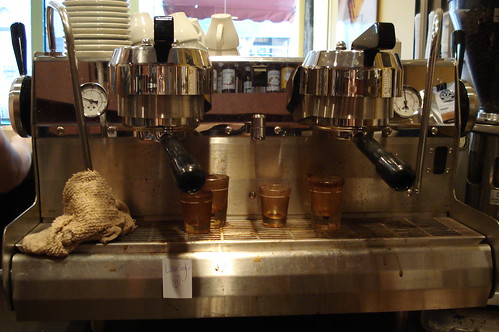A few months ago, during a manager's meeting, the subject of cleanliness came up. I mentioned some of the things I had learned while doing preliminary training for the NERBC with Nick Cho (whoops, I totally didn't compete! sorry!). I piped up that Nick had offered me a very compelling argument for not keeping spent coffee pucks in the portafilters in between shots, despite having been trained and trained again to do just that.
"It's like a wok," they always said!
"It's not like a wok," Nick Cho countered! But that, I guess, is another conversation for another day. Let's keep it simple today.
So during the meeting, I was going on and on about midshift maintenance and cleaning, about minimizing grounds waste, about how it's so frustrating and disheartening to walk onto a shift when the person before you hasn't (a) dosed directly and efficiently into their portafilter, (b) grabbed the next barista some clean rags, and/or (c) wiped the counter clean.
"Meister!" my boss said with a good-natured laugh. "What are you talking about? You're a mess!"
No kidding! But you know what? I had no idea! Totally oblivious.
Since then, I've done a lot of reading/thinking/cleaning/tasting. And it seems like the most obvious thing in the whole world, but it is brilliant and a complete revelation.
Coffee flavors are volatile, sensitive compounds that can be adversely affected by any number of factors. Nowhere is this more apparent than in relationship to machine cleaning. Espresso coffee that has been prepared on a dirty espresso machine attacks the taste buds with a mid-tongue bite that registers as a bitter-sour flavor. In fact, a clean espresso machine will foul in about 40 minutes after making a shot of espresso if oily deposits in the porta-filter and within the group head are left to become rancid. (David Schomer, Espresso Coffee: (Updated) Professional Techniques, p. 125)
So this is my new(est) project: Absolute attention to cleanliness. Empty portafilters, regularly backflushed lines (and not just at the end of the night, either), pristine and sterile rags, and some gentle-ish reminders to my staff to start thinking about doing the same.

This photo was snapped (quickly!) in the middle of an early-afternoon rush. It took me about a minute longer than it would have to clear the line out the door, but even without knowing it, my customers appreciate it.
The thing is unlearning an entire staff of their bad habits—especially when they used to be your bad habits! Especially when you personally, you as their trainer, taught them something you now believe to be wrong. What to do?
This is especially hard because I'm not around the store all that much these days—something that had already been giving me major agita, because I feel like I'm doing my charges a disservice by not being available for help, support and ongoing training. Short of sending email after email (which, let's face it, we're all tired of) or pulling each one of them aside and recommunicating this point, what is a part-time trainer to do? Simply teach by example?
I don't have the answers yet, but in the meantime, what is your take on the puck in/puck out debate?

